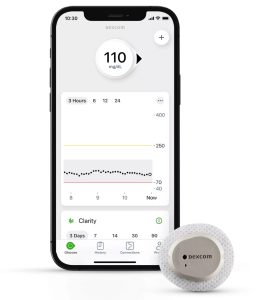 For individuals managing diabetes, staying abreast of the latest advancements in continuous glucose monitoring (CGM) is crucial. Dexcom, a prominent name in the industry, has unveiled the Dexcom G7, building upon the success of its predecessor, the Dexcom G6. If you are contemplating whether to leap to the G7, this comparison will help you weigh the pros and cons of these two groundbreaking devices.
For individuals managing diabetes, staying abreast of the latest advancements in continuous glucose monitoring (CGM) is crucial. Dexcom, a prominent name in the industry, has unveiled the Dexcom G7, building upon the success of its predecessor, the Dexcom G6. If you are contemplating whether to leap to the G7, this comparison will help you weigh the pros and cons of these two groundbreaking devices.
Advancements in Dexcom G7: A Closer Look
Released in early 2023, the Dexcom G7 offers several improvements over the G6 model. Let’s delve into the key features that set the G7 apart:
- Size and Placement: The G7 patch is half the size of the G6, offering more flexibility in placement. You can comfortably wear it on the back of the arm or the abdomen. An additional option for children aged two and above is to place it on their upper buttocks. The G7’s transmitter continues to transmit effectively over a distance of 20 feet and even underwater.
- Sensor Lifespan and Warm-up Time: While the G7 sensor has a lifespan of 10 days, it introduces a 12-hour grace period, allowing users some flexibility. Notably, the new G7 sensor significantly reduces the warm-up time from 2 hours to 30 minutes, enhancing coverage and efficiency.
- Improved Alarms: The G7 alarms have undergone enhancements, allowing users to delay the first alert for a high reading. Users can personalize alarms to silence or vibration.
- App Connectivity: The G7 streamlines connectivity by requiring only one app to connect up to 10 people and healthcare providers. The app offers comprehensive insights into sugar trends for various periods, ranging from 3 to 24 hours.
- Insulin Pump Connectivity: One limitation of the G7, as of September 2023, is its inability to connect to insulin pumps. The Tandem t:slim connects now, and users of the Omnipod 5 will have compatibility soon.
Performance Comparison: Dexcom G6 vs. G7
- Dexcom G6:
- Dexcom G7:
- MARD% Improvement: The G7 showcases enhanced accuracy with a lower MARD% of 8.2% for children and 8.1% for adults.
- Streamlined Connectivity: The G7 simplifies connectivity for both loved ones and healthcare providers using a single app. It extends the storage of blood glucose level data when out of reach to 24 hours, compared to the G6’s 3-hour limit.
Price & Monthly Cost Analysis
- Dexcom G6:
- Yearly Cost: Approximately $4800, with a monthly cost of around $400.
- Components: The transmitter costs about $300 and lasts three months. A pack of 3 sensors, lasting 30 days, costs about $300, plus the transmitter cost every 3 months.
- Dexcom G7:
- Yearly Cost: Approximately $4000.
- All-in-One Device: The G7 combines the transmitter and sensor into a single device used for 10 days. A pack of 3 devices costs approximately $340.
Usability & Comfort: Dexcom G6 vs. G7
- Dexcom G6:
- Design: The G6 is a small white and lilac-colored device commonly worn on the abdomen. Some users report itching and redness, requiring replacement. Setup is straightforward with a 2-hour warm-up.
- Dexcom G7:
- Design: The G7, more petite and rounder, is an all-in-one device appreciated for its ease of application. It can be worn on the arm, offering an alternative to the abdomen. It’s reduced warm-up time to 30 minutes and a 12-hour grace period are notable advantages.

Popularity & User Feedback
- Dexcom G6:
- Positive Reception: G6 garnered positive feedback, with users acknowledging a learning curve but highlighting its transformative impact on managing Type 1 Diabetes (T1D). Despite calibration and occasional sensor issues, users considered it a game-changer.
- Dexcom G7:
- Mixed Reception: G7’s reception varies, with users praising its small size but noting concerns about its tendency to fall off. Some users reported frequent disconnections, particularly during activities like exercise. The accuracy is appreciated, with reports of occasional false alarms and alarm setting changes.
In conclusion, upgrading from Dexcom G6 to G7 depends on individual preferences, priorities, and tolerance for potential limitations. While G7 brings notable improvements, such as enhanced accuracy, streamlined connectivity, and a more compact design, users must weigh these benefits against factors like price, usability, and ongoing user experiences. As advancements continue in continuous glucose monitoring, Dexcom remains a crucial player, empowering individuals on their journey to diabetes management.
